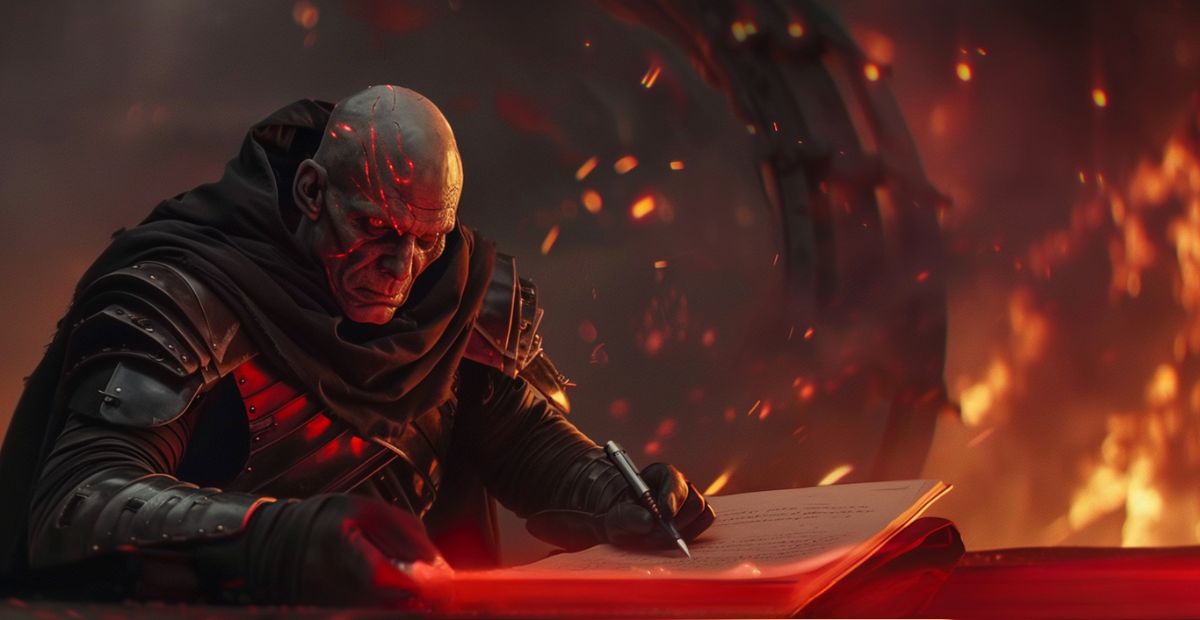Darth Bane, the formidable Dark Lord, single-handedly reshaped the Sith Order.
He dismantled the old order and, drawing upon the wisdom of ancient Sith Lords, established a new philosophy.
It was Darth Bane himself who laid the foundation for this new Sith Order.
Here are the five philosophies that Bane himself formulated and implemented in the new Sith Order.
Let’s begin!
Table of Contents
5. Bane’s Legacy and the Birth of the New Sith Order

Following the catastrophic Jedi-Sith War, it was believed that the Sith had been wiped out. Yet, Darth Bane, a lone Sith, survived the destruction. He identified the self-defeating habits of the Sith and realized a significant change was necessary.
Bane identified the weaknesses in the old Sith practices, especially their tendency for internal conflicts and power struggles, which he thought led to their collapse.
Bane made a decision to obliterate the old Sith Order using a thought bomb, with the intention of establishing a new Sith Order based on his philosophy.
This new organization, known as the Order of the Sith Lords or simply the Sith, was an ancient group of Force-sensitive individuals who harnessed the dark side of the Force.
Unlike the old order where the Sith were numerous and often openly confronted the Jedi, this new order operated covertly, manipulating events from the shadows. They would patiently wait for the opportune moment to strike against the Jedi.
Bane’s philosophy ushered in a new period for the Sith. It was an era of patience, strategy, and discreet manipulation.
The Sith transformed from a horde into a clandestine order, secretly scheming the downfall of the Jedi and the establishment of a new Sith Empire.
4. Revised the “Darth” Title
By the era of Darth Bane, around 1,000 BBY, the Sith had stopped using the title “Darth”. This was mainly to avoid disputes, as the title was often linked with power and authority. Instead, most Sith preferred the title “Dark Lord”.
However, Bane saw the importance of the title and chose to bring it back when he established the Rule of Two.
He felt that the title “Darth” symbolized competition and individual power, which were key elements of his new philosophy.
The Rule of Two meant that there could only be two Sith at any one time – a Master to hold the power and an Apprentice to desire it.
In keeping with this, Bane adopted the title of Darth for himself and also gave it to his apprentice, Darth Zannah.
This signaled the return of the title “Darth” in the Sith Order, and it was used by all future Sith Lords under the Rule of Two.
In summary, Darth Bane reformed the use of the “Darth” title by reintroducing it and making it a crucial part of the Sith identity in his new order.
3. The Rule of Two

Why just two, one Master and one Apprentice? The answer lies in what Bane learned from Revan’s holocron.
Specifically, the part that inspired Bane to create the Rule of Two states, “A Master who teaches more than one apprentice in the ways of the dark side is unwise.
Over time, the apprentices will combine their strength and overthrow the Master. This is inevitable and self-evident. That’s why each Master should have only one student.”
This rule dictated that only two Sith Lords should exist at any given time: a master to embody the power of the dark side of the Force, and an apprentice to desire it, learn from the master, and eventually take their place.
The rule became the guiding principle for the Lords of the Sith.
This new framework drastically altered the dynamics of the Sith Order. The Rule of Two allowed the Sith to work in secrecy, scheming their ascent to power from the shadows.
It also ensured the Sith’s strength, as the apprentice could only ascend to the position of master by demonstrating their power and cunning.
2. The Apprentice Can Become the Master

Darth Bane established the Rule of Two, a core principle of the Sith Order. This rule states that there can only be two Sith at any time: a Master to hold the power, and an Apprentice to desire it. This isn’t just a guideline, but a system for succession within the Sith Order.
The Master-Apprentice relationship is characterized by power dynamics and ongoing tension.
The Master possesses the power and teaches the Apprentice. In turn, the Apprentice is expected to desire this power and continually strive to enhance their strength.
The ultimate challenge for the Apprentice is when they feel they’ve become strong enough to confront their Master.
If the Apprentice can overthrow and eliminate their Master, they prove their worthiness of the Master title. They then recruit their own Apprentice, and the cycle goes on.”
For instance, consider how Darth Sidious overthrew his master, Darth Plagueis, to seize control over everything his master had created.
Furthermore, Darth Sidious demonstrated his cunning by recruiting multiple apprentices over time, from Maul to Dooku, and finally, Darth Vader.
1. The Secretive Strategy of Darth Bane’s Sith Order

The principle of “Operating in Secret” is a fundamental shift in the Sith Order’s approach under Darth Bane’s Rule of Two.
Unlike the old Sith Order, which often openly opposed the Jedi and engaged in large-scale conflicts, Bane’s Sith Order operated from the shadows.
This covert approach allowed the Sith to plot their rise to power without attracting the attention of the Jedi.
They manipulated events from behind the scenes, influencing galactic politics and setting the stage for their eventual takeover.
Operating in secret also meant that the Sith could bide their time, waiting for the perfect moment to strike. This required patience and strategic planning, traits that were highly valued in Bane’s Sith Order.
Moreover, this approach ensured the survival of the Sith Order. By remaining hidden, they avoided direct confrontation with the Jedi, who were far more numerous and powerful.
This allowed the Sith to grow in strength and cunning, preparing for the day when they would finally reveal themselves and seize control of the galaxy.
In essence, the principle of “Operating in Secret” is about survival, patience, and strategic planning.

